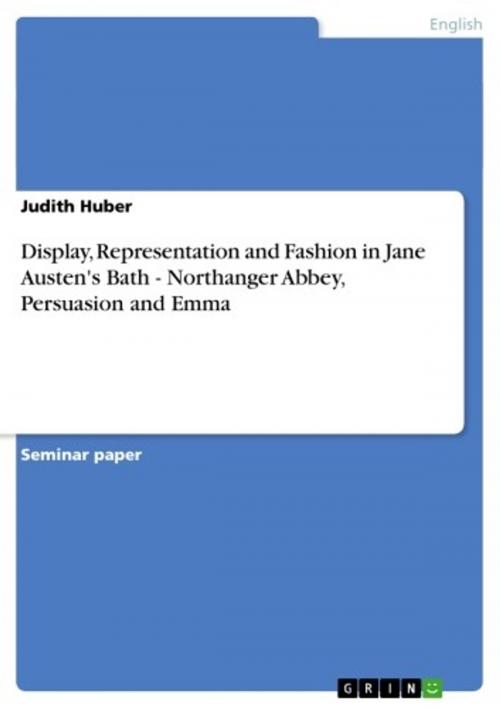Display, Representation and Fashion in Jane Austen's Bath - Northanger Abbey, Persuasion and Emma
Northanger Abbey, Persuasion and Emma
Fiction & Literature, Literary Theory & Criticism, British| Author: | Judith Huber | ISBN: | 9783638227612 |
| Publisher: | GRIN Publishing | Publication: | October 30, 2003 |
| Imprint: | GRIN Publishing | Language: | English |
| Author: | Judith Huber |
| ISBN: | 9783638227612 |
| Publisher: | GRIN Publishing |
| Publication: | October 30, 2003 |
| Imprint: | GRIN Publishing |
| Language: | English |
Seminar paper from the year 2003 in the subject English Language and Literature Studies - Literature, grade: 2 (B), University of Hamburg (Institute for Anglistics/American Studies), course: Proseminar 'From Funny Fop to Dangerous Dandy - Fashion in 17th and 18th Century Literature', 9 entries in the bibliography, language: English, abstract: The city of Bath has served as the scene of many 18 and 19 century novels, like Daniel Defoe's Moll Flanders, Tobias Smollet's Roderick Random, Henry Fielding's Tom Jones and, of course, Jane Austen's Northanger Abbey; Persuasion and Emma. In Bath, one could find the quintessence of all the illusions, values and con- th flicts of the 18 century (Hill 1989: 2); its rules of etiquette fixed by Richard 'Beau' Nash influenced 'the manners of the entire nation throughout the Georgian era'. An official Bath guide read that the city had 'become one of the most agreeable as well as most polite places in the Kingdom' (Watkins 1990: 178). But as the century wore on, the spa became less fashionable, the nobility became bored of it, and middle class people swamped the town. The three novels by Jane Austen mentioned above date from this time, when Bath's heyday was over. In my opinion, it is particularly interesting to take a look on the image of Bath as it is conveyed by these three novels, because of the different viewpoints of the characters: In Northanger Abbey, the city is described from a middle class perspective, in Persuasion from an upper class perspective, and in Emma, where none of the action actually takes place in Bath, we get an idea of what people in the country thought about the city of Bath; it is described from an extern point of view. This paper will examine the literary characterisation of the city as a place of amusement (balls, concerts, etc.), display and representation by looking at the characters' attitudes towards Bath and the purpose of their stay there. The further aim is a cultural description of the city with regard to its fashionableness, based on the novels of Jane Austen.
Seminar paper from the year 2003 in the subject English Language and Literature Studies - Literature, grade: 2 (B), University of Hamburg (Institute for Anglistics/American Studies), course: Proseminar 'From Funny Fop to Dangerous Dandy - Fashion in 17th and 18th Century Literature', 9 entries in the bibliography, language: English, abstract: The city of Bath has served as the scene of many 18 and 19 century novels, like Daniel Defoe's Moll Flanders, Tobias Smollet's Roderick Random, Henry Fielding's Tom Jones and, of course, Jane Austen's Northanger Abbey; Persuasion and Emma. In Bath, one could find the quintessence of all the illusions, values and con- th flicts of the 18 century (Hill 1989: 2); its rules of etiquette fixed by Richard 'Beau' Nash influenced 'the manners of the entire nation throughout the Georgian era'. An official Bath guide read that the city had 'become one of the most agreeable as well as most polite places in the Kingdom' (Watkins 1990: 178). But as the century wore on, the spa became less fashionable, the nobility became bored of it, and middle class people swamped the town. The three novels by Jane Austen mentioned above date from this time, when Bath's heyday was over. In my opinion, it is particularly interesting to take a look on the image of Bath as it is conveyed by these three novels, because of the different viewpoints of the characters: In Northanger Abbey, the city is described from a middle class perspective, in Persuasion from an upper class perspective, and in Emma, where none of the action actually takes place in Bath, we get an idea of what people in the country thought about the city of Bath; it is described from an extern point of view. This paper will examine the literary characterisation of the city as a place of amusement (balls, concerts, etc.), display and representation by looking at the characters' attitudes towards Bath and the purpose of their stay there. The further aim is a cultural description of the city with regard to its fashionableness, based on the novels of Jane Austen.















